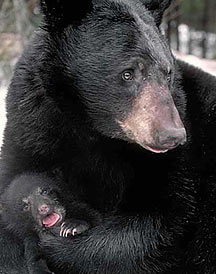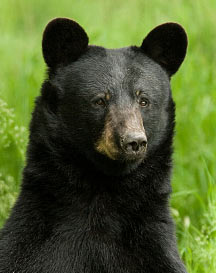https://www.google.com/url?rct=j&sa=t&url=http://www.cbc.ca/1.3853797&ct=ga&cd=CAEYCioUMTI0NTMyNjcyNjAwMjYxMTg5MzUyGjU2ZDFlN2YxOWU4Zjk5OTE6Y29tOmVuOlVT&usg=AFQjCNGogK9mCkfj6ojMc8zE6l0veG_Hgg
http://bearsmartnj.org/


Like mother, like cub: researchers say grizzlies learn bad behaviour from moms
Baby bears get bad habits from their matriarch
By John Cotter, The Canadian Press Posted: Nov 16, 2016 1:06 PM MT
When it comes to bad behaviour in grizzly bears, new research blames the moms.
A University of Alberta study suggests that cubs who have watched their mothers come into conflict with people are more likely to do so as well.
Wildlife ecologist Andrea Morehouse says it's evidence of social learning in grizzlies.
"Bear biologists have long suspected that cubs learn behaviours," she said Wednesday.
"If we can stop female grizzlies from becoming problem bears in the first place, we can prevent the social learning of problem behaviour in cubs and help stop the cycle at its source."
The research is published in the online science journal PLOS ONE.
The findings are based on a study of 2,043 grizzlies in Alberta, British Columbia and Montana that was done with the United States Geological Survey.
Morehouse and her colleagues created family trees of grizzly bears using DNA samples taken over the years from captured bears or from fur collected from trees and fences bruins rubbed again.
Researchers focused on specific grizzlies that had been involved in attacks on people, livestock or pets, as well as on bears that had broken into grain bins or fed on garbage.
They found a link between mother bears and cubs when it came to problem behaviour. The link wasn't there with father bears.
"With grizzly bears, cubs stay with their moms for about two to three years," said Morehouse. "It is just the moms that are involved in the rearing of the offspring. Male grizzly bears are not involved in that."
Nature versus nurture
Morehouse said the findings suggest behaviour is not passed down genetically. They also point to the need for people to help prevent problem behaviour in mother grizzlies.
Measures researchers recommend include increased use of electric fencing, tougher handles on grain bins to make them more difficult for bears to open, quick removal of dead livestock and securing garbage in bear-proof containers.
Parks Canada says about 20,000 grizzly bears remain in British Columbia, Alberta, Yukon and the Northwest Territories.
Researchers estimate there are about 700 of the bears in Alberta, where the species is listed as threatened.
Morehouse said it is possible to condition problem bears to avoid people by scaring them using small explosives called bear bangers, shooting them with rubber bullets or confronting them with specially trained dogs.
But preventing bad bear behaviour in the first place is more effective, she said.
"The main message is we can try and prevent the behaviours that we don't want to see develop."
--------------------------------------------------------------------------------------------------------
Bear Smart New Jersey is a public service program of the Bear Education And Resource program.
The primary mission of BEAR is to protect black bears and their habitat. Our Bear Smart Community outreach program serves to educate residents about bears, reduce unwarranted fears and increase tolerance of our bear neighbors.
Both our protection and education objectives foster a peaceful coexistence and replaces fear with respect and understanding.
Bear Smart New Jersey was inspired by the desire to offer communities the means to reduce human/bear interactions, to educate the public on the true nature of bears and to create an environment where bears and people can peacefully co-exist.

The concept of Bear Smart communities has its origins in Canada in the resort community of Whistler, British Columbia. Helping residents, visitors and businesses make Whistler a model Bear Smart community that ensures the safety of both people and bears is at the heart of their work.
Traditionally, New Jersey wildlife officials have handled human/bear conflict situations through hunting regulations and killing or relocating “nuisance” bears; these methods have not prevented conflicts or even reduced their numbers.
The ineffectiveness of traditional methods points to a clear need for the Bear Smart approach.
It takes a village to create a Bear Smart community. When everyone participates - private homeowners, businesses, campgrounds and public policy makers - it’s easy to be Bear Smart, at home, at work and at play!

As more and more people unfamiliar with black bears move into New Jersey’s bear country, there is a hightened need for public education, the corner stone of a Bear Smart program.
Bear Smart programs include public education, appropriate garbage containment, enforcement of feeding ban laws and training for police officers and wildlife personnel. Coalition building with community and state organizations enhances the effectiveness of Bear Smart programs.
It takes a village to create a Bear Smart community. When everyone participates, private homeowners, businesses, campgrounds and public policy makers, it’s easy to be Bear Smart - at home, at work and at play!











No comments:
Post a Comment